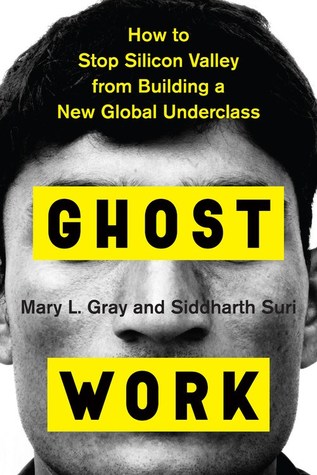
Ghost Work
How to Stop Silicon Valley from Building a New Global Underclass
کتاب های مرتبط
- اطلاعات
- نقد و بررسی
- دیدگاه کاربران
نقد و بررسی

February 25, 2019
This revealing economic ethnography from anthropologist Gray and computer scientist Suri, both of whom work for Microsoft, sympathetically tells the stories of “ghost workers” who assist computers in replicating human cognition. These workers sign on through clearinghouses such as Amazon’s Mechanical Turk to perform tasks—writing subtitles for videos, identifying offensive content or animal pictures—remotely and for very low pay. Lack of transparency about the workers’ existence, the authors argue, gives the impression that artificial intelligence alone is powering ride sharing apps, internet searches, and other contemporary conveniences. Gray and Suri, who traveled to interview and observe ghost workers in the U.S. and India, explain that ghost workers are a vulnerable labor force; they have no rights as employees and little recourse if they are wrongfully fired or go unpaid. Yet the authors find that the anonymity and flexibility is a boon to some, such as female and disabled laborers who would otherwise face discrimination, and caregivers who need flexibility. To combat exploitation, Gray and Suri call for benefits for workers, unions, and new clearinghouses that allow for human communication between employer and employee. This compassionate and informative study is a must-read for anyone interested in the future of work.

April 1, 2019
An exploration of the hidden human labor force that works with artificial intelligence to power many popular websites and apps. As Microsoft Research senior analysts Gray and Suri note, some 20 million individuals worldwide make up an "on-demand gig economy," working as freelancers to handle judgment-call tasks that computers do not do--from moderating content and editing product reviews to developing web pages--and executing such high-tech piece work (for apps like Uber and websites like Facebook) in isolation, amid great uncertainty, without feedback or benefits, and under no clear labor laws. Drawing on a pioneering five-year study of workers in the United States and India, the authors provide a revealing, overly detailed view of this rapidly growing world of "ghost work," in which "faceless" labor platforms (at the behest of well-known firms) hire workers represented by numbers rather than names. The platforms organize, route, and schedule projects to individuals working from home or elsewhere. This prospect--not the takeover of work by robots--represents the "inevitable" future of jobs, argue the authors. The book includes portraits of many workers such as Karen, a 37-year-old stay-at-home mom who does captions for an on-demand platform called Amara, earning $15 per hour; and Zaffar, 26, an IT graduate who handles tasks for LeadGenius, another platform, from his home in India. Most are college graduates under age 40, and many have failed to find--or do not want--9-to-5 jobs. Some are disabled, retired, or caring for children or elderly relatives; all take on first-come, first-served assignments at their convenience. Worker experiences are mixed: Some hustle to land steady work, while others find some of the hundreds of platforms (Amazon's MTurk, Microsoft's UHRS, LeadGenius, and Amara are examined in detail) hard to understand. Nearly a third report being unpaid for work completed. The authors urge many reforms, including a safety net for future workers and "company-issued, shared workspace." A sobering book for policymakers and anyone considering on-demand gigs.
COPYRIGHT(2019) Kirkus Reviews, ALL RIGHTS RESERVED.

























دیدگاه کاربران